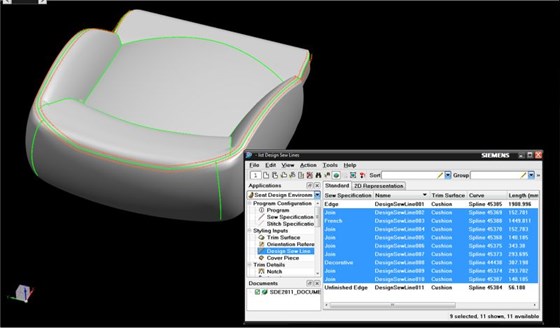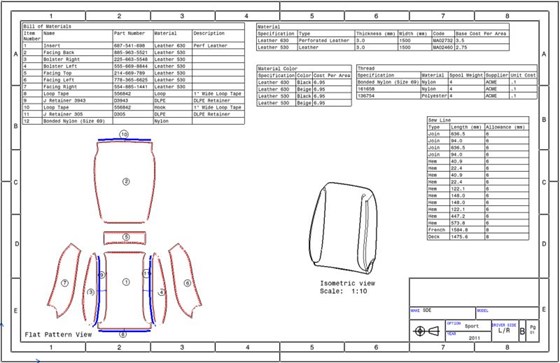
A complete seam definition in SDE comes from it converting curves into seams by associating 2D to 3D attributes, including seam, thread or needle type, and length to a curve. SDE automatically combines these seams into pieces, which are associated with materials.

SDE can generate engineering drawings as required for the seat covers, drawings that can show the BOM (top), flat patterns (bottom left), isometric views (bottom middle), and sewing details (bottom right).
Previous
Next
Related:
Automotive Interiors
Digital Domain
Related Suppliers
-
Siemens PLM Software
Seats are one of the costliest assemblies in a car, and seat trim covers are one of the most complex. The Seat Design Environment (SDE) from Siemens PLM Software (siemens.com/plm) automates the otherwise laborious process of seat trim definition into an automated progression of steps.
Years ago, Steve Luby and Edward Bernardon worked together at Draper Labs building manufacturing equipment for making composite parts. Their work eventually became software products sold by Vistagy. Siemens PLM Software bought Vistagy in December 2011, renaming it the “Specialized Engineering Software (SES) Business Segment.â€
The initial software product was Fibersim, a suite of software for designing and manufacturing composite parts primarily in aerospace and automotive. Composites, says Luby, senior vice president, SES, are “fraught with design uncertainties.†A change in the parameters of shape, material, or manufacturing process can affect the rest. Luby believes it’s nearly impossible to design composite parts and account for, let along optimize, all the complexities in constraints without the help of information technologies. Contrast that with metal parts: the few design and manufacturing constraints that exist are well understood. Hold these thoughts.
Another product, SDE, is for designing and manufacturing transportation seats and interiors. SDE captures a complete digital product definition for, say, a car seat cover in a single master model.  When including the seat, cushion, backrest, and other parts of a seat, a seat cover can have roughly 5,000 attributes. These are mostly non-geometric pieces of data in addition to the geometry, explains Edward Bernardon, SES vice president of strategic automotive initiatives. For instance, there’s the type of seam, number of stitches per inch in the seam, thread color, thread tension, type of sewing needle, seat material, and manufacturing sequence. Each attribute needs to be defined for each seam, for every curve in the 3D model of the seat cover.
The common theme for Fibersim and SDE, explains Bernardon, is that they transform a 3D shape of a flexible material—metal for Fibersim, fabrics for SDE—into a flat pattern to cut out, lay out, and put together (weld, bolt, lock together, or, for SDE, sew together). Another common theme is that very complex products can’t be defined just by geometry alone. “Our tools help turn requirements into detail geometry. And when you make changes to the requirements, they get reflected in the geometry,†says Luby. Shoveling all these attributes into a PDM or PLM system, and having either system manage those data— the CAD model with geometric and non-geometric data—“is pretty conventional,†says Bernardon. “What’s unique is that the SDE is a repository of data and, more importantly, it’s an efficient authoring system for that repository.â€
Capturing seat attributes
Everything in SDE hangs on the 3D master model. The core, the 3D geometry of the seat, is created the conventional way, using styling software or a combination of styling software and CAD. SDE works as a plug-in to CAD—even non-Siemens CAD systems.
Users add attributes through a series of data entry boxes arranged in the way seat covers are developed. By linking to click-and-pick thread, material, and sew specification libraries, the SDE seam definition menu helps the engineer choose and associate, say, a French seam on a curve in the 3D model, a join seam on another curve, and so on until all the curves are defined, as well as the number of stitches per inch, color, number of threads, and other attributes. A materials menu prompts for the fabrics to use (leather, simulated leather, cloth, vinyl, etc.). At some point, SDE leads the engineer to sequence the cutting and sewing of pieces together.
Once these attribute data are entered, users can filter and format the data to produce sewing instructions, BOMs, and other informative documents. For example, SDE can automatically create a spreadsheet for costing the seat cover. Rather than “historical-based costingâ€â€”what did this seat cover cost the last time it was made, plus some percentage points for additional nips and tucks, and inflation—accounting can now know exactly what materials are required to make the seat, plus, using standard practices, how much time to cut, stitch, and otherwise assemble all the fabrics together into a finished seat cover. OEMs have control of the bidding process because they can now compare apples to apples; that is, suppliers are bidding on the same known requirements. The Tier 1s like SDE because now the OEM can’t change a now very-precise request-for-quotation that is based on a near-proven, albeit virtual, seat cover design within SDE.
SDE is a software system that permeates the entire company. Design, manufacturing, purchasing, finance, and IT can tap into the 3D master model. Doing so effectively reduces time-to-market in a multitude of ways: increase data reuse, reduce design time, automate repetitive manual tasks (such as summing up the amount of materials to be used in making the seat covers, including thread lengths, fabric area, etc.), reduce time to generate BOMs and cost estimates, fewer physical prototyping, fewer design and manufacturing errors, better communication between OEMs and suppliers, enhance parts/assemblies sourcing, and reduce the time to initial drawings, manufacturing documentation, updated drawings, and quotations.Â








